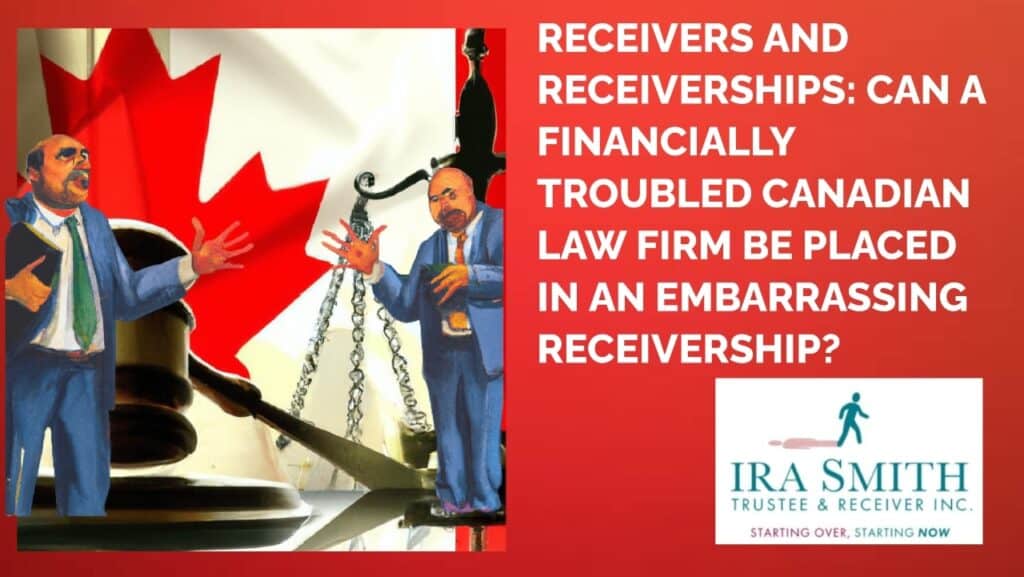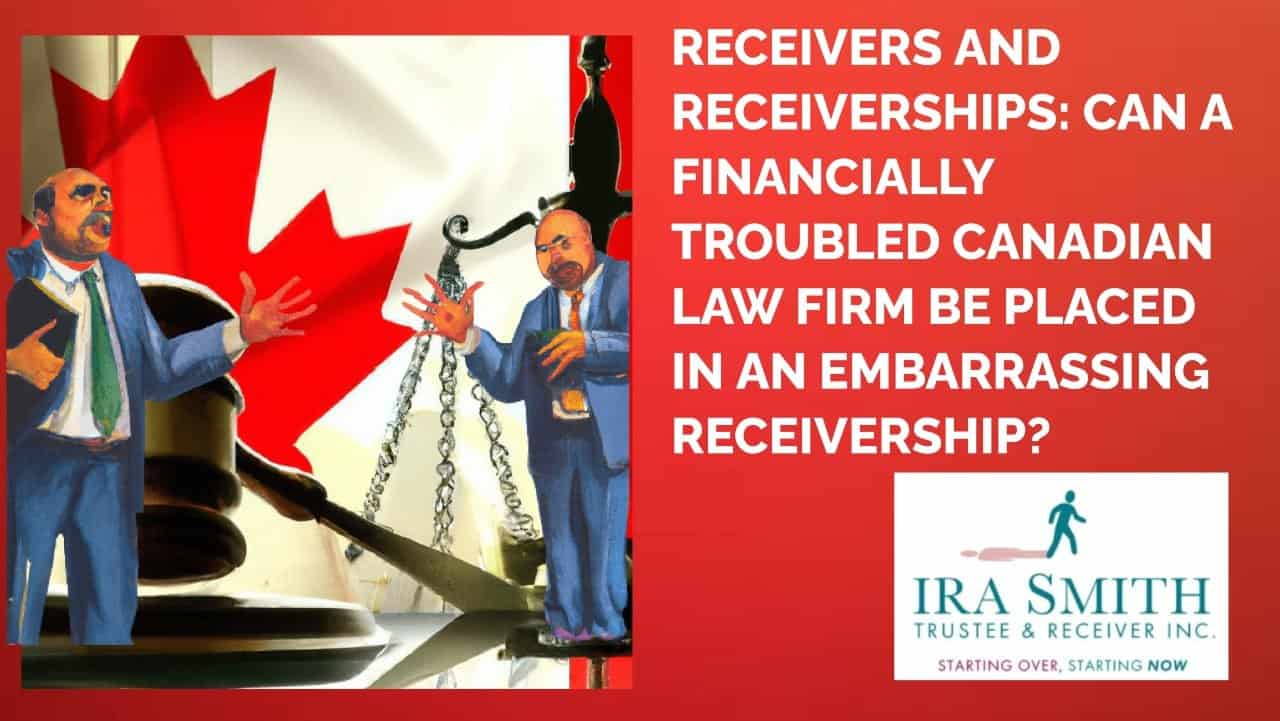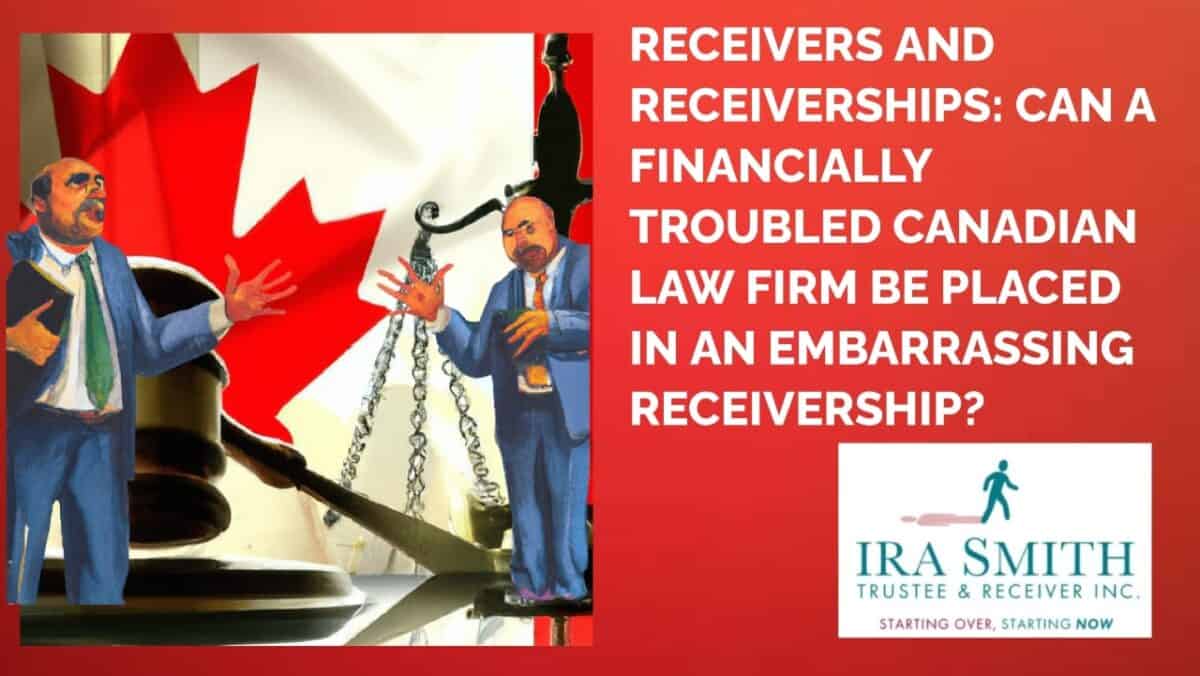Receivers and receiverships: Introduction
Imagine a prestigious Canadian law firm, typically the epitome of stability and justice, suddenly hit by a financial storm. The once robust balance sheets now shake, and partners are left to navigate a legal and financial labyrinth they never expected. This Brandon’s Blog takes you on a journey through the intersection of law and finance, revealing the truth behind what happens when even the legal giants fall on hard times.
Financial turbulence is a universal challenge affecting any business, including law firms. In the context of Canadian law firms, the concept of receivers and receiverships is unique, and the Court of King’s Bench of Alberta grappled with this issue in a recent case. Join us as we explore the legal strategies, regulations, and complexities of a financially challenged Canadian law firm placed in receivership.
Definition of receivers and receiverships
What Is Receivership?
Receivers and receiverships are a legal process that includes the retention of a 3rd party, referred to as a receiver, to take control of a company’s assets, finances and operations in an effort to resolve the underlying economic problems. Receivership is a lawful remedy used when a company, sole proprietorship, partnership or person, even including a law office, encounters impossible monetary issues. Receivers and receiverships can be used either to restructure a business by separating the good assets from the horrific financial problems or for a straight liquidation.
Receivership is a legal system where a secured creditor either independently designates or petitions the court to appoint a 3rd party, described as a receiver, to manage the properties and affairs of a business or person. Receivers and receiverships become a multifaceted process imbued with complexity. This option regularly serves as an avenue for the reconfiguration of a faltering business or the resolution of financial disagreements among diverse parties.
Navigating receivership involves a formidable blend of legal acumen and also the capability to make wise financial judgments. It is incumbent upon companies and people alike to realize the far-reaching ramifications of receivers and receiverships as well as the prospective scenarios that might ensue from its invocation. Among these considerations lies the essential issue of its repercussions on stakeholders, including employees, unsecured creditors, as well as lenders.
Within Canadian territory, the mantle of a receiver can solely be born by an appropriately qualified licensed insolvency trustee to manage this intricate legal process.
When Is Receivership Considered?
Receivership ends up being a factor to consider when a business experiences severe financial distress, such as mounting financial debts, operational inadequacies, or the inability to satisfy financial commitments. It works as a last resource to salvage what continues to be of the firm’s assets.

Receivers and receiverships laws in Canadian provinces: Overview of the legal framework for receivership in Canada
Canada’s legal landscape is complicated, with federal and provincial laws and guidelines controlling the process of receivership. Let us explore this further.
Federal Laws
In Canada, the procedure of receivership is regulated mostly by federal government regulation, the Bankruptcy and Insolvency Act. The receiver must act lawfully. In a court appointment, the receiver must act in the very best interests of all parties involved. In this type of appointment, receivers as well as receiverships go through oversight by the court. The procedure of receivership can be complicated as well as calls for well-informed legal and financial recommendations to guarantee an effective outcome.
Provincial Regulations
Provinces in Canada also have their own laws which intersect with receivers and receiverships. Examples of provincial regulations that could affect receivers and receiverships are:
- the actual statute under which a court supervises receivers and receiverships;
- food and beverage service;
- landlord and tenant.issues;
- real property laws;
- employment laws; and
- environmental regulations.
Receivers and receiverships: Signs of financial troubles in Canadian law firms
Early signs of law firm financial distress may manifest discreetly initially; however, they possess the potential to swiftly burgeon into more significant predicaments if they remain unaddressed. These initial cues often comprise a diminution in earnings or profits, the gradual accumulation of aged or unrecoverable accounts receivable, protracted deferrals in settling obligations with suppliers, elevated turnover ratios among the workforce, and a conspicuous dearth of financial commitment to technological advancements or educational initiatives.
Furthermore, additional red flags might encompass extravagant expenditures on non-essential items, an absence of transparency in financial disclosures, and an excessive reliance upon a select few pivotal clientele for the lion’s share of the generated income. It is of paramount importance for legal practitioners to diligently oversee their fiscal well-being and to adopt assertive measures for rectification as soon as such issues come to the fore. These remedial actions may encompass the implementation of cost-saving measures, the pursuit of novel revenue streams, and judicious investments in pivotal facets of their enterprise to maintain a competitive edge within the industry.

Receivers and receiverships: Initiating receivership proceedings
Secured creditors and their loans
In the intricate tapestry of the Canadian receivership process, secured creditors assume a pivotal role, being the foremost lenders vested with a security interest in the debtor company assets. This security interest, the secured loan being a legal tether of paramount significance, empowers them to wield their influence with precision, invoking either the private appointment of a receiver or the judicial machinery to issue an order for a court-appointed receiver.
In the realm of receivers and receiverships, this designated receiver takes upon themselves the onerous task of seizing the reins and stewarding the debtor company’s possessions.
Empowered by their position, secured creditors hold sway over the inception of the receivership process, their voices resonating in the selection of the receiver, a decision of paramount consequence. This influence is not merely titular; it is wielded to safeguard their interests and optimize the potential for recovery.
Types of receivers and receiverships: Role of receivers in legal proceedings
There are two types of receivers and receiverships:
Privately-appointed receiver
In privately appointed receiverships, the receiver bears the weighty mantle of responsibility, owing a fiduciary duty to the secured lender, a commitment to act in their utmost interest. Secured creditors, in turn, possess the authority to interpose their veto, casting judgment upon select decisions proposed by the receiver.
Court-appointed receiverships
However, when the path leads to court-appointed receivership, a different dynamic emerges, for here, the receiver is an independent arbiter, an officer of the court, rendering decisions with impartiality. No doubt secured creditors will attempt to wield their influence, but the court-appointed receiver must be seen to be even-handed.
In the grand scheme of the Canadian receivership process, secured creditors emerge as the linchpin upon which rests the beginning of efficient oversight and resolution of a debtor’s financial quagmire.

Receivers and receiverships case study: A recent instance of a Canadian law firm receivership process
The recent decision of the Court of King’s Bench of Alberta is in the case of Law Society of Alberta v Higgerty, 2023 ABKB 499. This case involves an application to put a law firm into receivership. Notwithstanding that it is not one of the larger firms, it is, in my view, having been involved in both the receiverships and bankruptcies of law firms, a complete analysis of all the important considerations that insolvency practitioners and non-insolvency lawyers must be aware of in either advising or dealing with an insolvent law firm.
Law firm receivers and receiverships: Background
The Law Society of Alberta (“LSA”) and Mr. Richard E. Harrison are the applicants on this matter (collectively, the “Applicants”). The Applicants seek an order appointing a receiver or a receiver and manager over certain undertakings, personal property, real property and assets of the law practices of Patrick B. Higgerty and Patrick B. Higgerty Professional Corporation (collectively, “Higgerty Law”).
The receivership order sought by the Applicants is unique because of the circumstances underlying this application (the “Application”). The tension in this Application concerns: (i) the desire of a secured lender to enforce its rights and entitlements under the security it holds over the assets held by Higgerty Law; and (ii) the desire of the LSA to ensure the parties are acting in the public interest and to protect solicitor-client privilege that is a component of the files of Higgerty Law.
Easy Legal Finance Inc (“ELFCo”) is a secured lender to Higgerty Law. It seeks the right to enforce its security which is part of the loan agreement. It proposes a process that it alleges will ensure confidentiality and solicitor-client privilege are maintained for stakeholders, and not strip ELFCo of substantially all of its contractual, legal and beneficial rights.
Law firm receivers and receiverships: Facts
During its years of operation, Higgerty Law focused on personal injury law and class action litigation. Compensation for those files was often based on contingency fee agreements, payable when the matter concluded. On March 10, 2023, Higgerty Law was placed under custodianship pursuant to an Order of this Court (the “Custodianship Order”). Mr. Harrison was named the custodian (the “Custodian”).
On the date the Custodianship Order was issued, Higgerty Law had a substantial number of creditors. ELFCo asserted it held security over all present and after-acquired personal property of Higgerty Law. ELFCo claims that its security gives it priority over the proceeds of the class action lawsuits.
Higgerty Law has a debt of around $1.4 million to ELFCo. The interest rate charged on the ELFCo Loan is a whopping 18% per year! Last April, ELFCo served a demand for payment and a notice to enforce security under section 244(1) of the Bankruptcy and Insolvency Act (R.S.C., 1985, c. B-3) (“BIA”).
The President of ELFCo swore in an affidavit that he believed there was no reasonable prospect of Higgerty Law repaying the ELFCo Loan.
Law firm receivers and receiverships: What the Court needed to address
Initially, several issues were to be addressed in the Application, including: (i) whether a receiver and manager should be appointed; (ii) whether the interest payable on the ELFCo Loan should be stayed; and (iii) the scope of the ELFCo Loan security. The parties agreed to restrict the hearing to the issue of whether a receiver and manager should be appointed. The other issues were deferred to a subsequent hearing.
ELFCo challenges the proposal to appoint a receiver and manager. It asserts there is no business of Higgerty Law to manage and no material estate to administer. ELFCo also asserted that a receiver and manager in these circumstances would be limited to the negotiation of the transfer of a limited number of legal files to new lawyers. It submits that this is not an appropriate mandate for a receiver and manager and that it would not be commercially reasonable in view of the needless cost and redundancy a receivership would create.
As an alternative, ELFCo made an application for approval of a basic process to enforce its security. It asserts that this alternative process would ensure that confidentiality and solicitor-client privilege are maintained for stakeholders. Further, ELFCo asserted that this alternative process would not strip it of substantially all its rights and entitlements under its security, which would occur under the Custodian’s proposal. The one thing that the ELFCo proposal failed to recognize is that under section 244(4) of the BIA, only a licensed insolvency trustee can act as a receiver.
The unique circumstances of this case presented a challenge for the Court because there are various stakeholders with different rights that must be balanced, including:
- the rights of the Higgerty Law clients to have their solicitor-client privileged communications protected;
- the entitlement of a secured creditor to enforce its legal and beneficial rights;
- the rights of Higgerty Law clients whose funds appear to have been misappropriated;
- the rights of Higgerty Law clients to access their file material; and
- the rights of unsecured creditors, including clients of Higgerty Law.
A wide array of factors should be taken into consideration when considering receivers and receiverships
The Court considered a list of important factors in considering a receivership appointment:
- whether irreparable harm might be caused if no order were made, although it is not essential for a creditor to establish irreparable harm if a receiver is not appointed, particularly where the appointment of a receiver is authorized by the security documentation;
- the risk to the security holder, taking into consideration the size of the debtor’s equity in the assets and the need for protection or safeguarding of the assets while litigation takes place;
- the nature of the property;
- the apprehended or actual waste of the debtor’s assets;
- the preservation and protection of the property pending judicial resolution;
- the balance of convenience to the parties;
- the fact that the creditor has the right to appoint a receiver under the documentation provided for the loan;
- the enforcement of rights under a security instrument where the security-holder encounters or expects to encounter difficulty with the debtor and others;
- the principle that the appointment of a receiver is extraordinary relief, which should be granted cautiously and sparingly;
- the consideration of whether a court appointment is necessary to enable the receiver to carry out its duties more efficiently;
- the effect of the order upon the parties;
- the conduct of the parties;
- the length of time that a receiver may be in place;
- the cost to the parties;
- the likelihood of maximizing return to the parties;
- the goal of facilitating the duties of the receiver.
Ultimately, the Court has to decide if, under provincial law, on the balance of the evidence, is it just and convenient to appoint a receiver.
Receivers and receiverships: The evidence and the Court’s analysis
The evidence, in this case, is that:
- there are trust account improprieties in the range of $419,000; and
- there is no reasonable prospect of the Applicants or Higgerty Law repaying the ELFCo Loan or continuing to make loan payments.
By virtue of being members of the LSA, custodians can maintain solicitor-client privilege over files and information within their custody. Both the LSA and the Custodian are stakeholders in ensuring the maintenance of solicitor-client privileged information.
There is an important distinction between secured creditors, who are interested in protecting themselves and usually do so through a receiver that they appoint, and a custodian who is typically interested in protecting the clients of the financially troubled law firm and their respective rights and entitlements, including their respective rights to solicitor-client privilege.
From the perspective of the secured creditors, the results which flow from the appointment of a custodian are no happier. A custodian is obliged by the to protect the interests of clients of the firm, including confidentiality, and is consequently unable to collect accounts receivable either efficiently or economically. The task of the custodian is significantly dissimilar from that of the receiver in that the primary objective of the custodian is the protection of clients’ interests. Receivers, by contrast, act in accordance with the interests of creditors. Any benefit enjoyed by creditors which results from the appointment of the custodian is merely incidental to the primary function of the custodian, which is the protection of the clients.
Solicitor-client privilege is a fundamental underpinning of the legal profession in Canada. It is near absolute and merits protection.
Solicitor-client privilege cannot be breached by the interests and entitlement of a secured creditor. Any risks in that regard must be carefully considered. To illustrate this point, the Supreme Court of Canada has held that Anton Piller orders must ensure the protection of the solicitor-client communications of the party being searched. There is no right to disclosure of such communications in discovery because they are protected by privilege.
The Judge determined that the higher duty in the circumstances of this case is to protect the public interest, which includes the protection of privilege associated with the files of Higgerty Law. Given the inherent concerns associated with the issues touching on the “Property” as that term is defined in the Draft Receiver Order, it is inevitable that matters concerning the solicitor-client privilege over the Higgerty Law files will be engaged. As a regulator, the LSA has an obligation to ensure the parties are acting in the public interest and to protect privilege over the Higgerty Law files.
The Judge’s view was that protecting solicitor-client privilege is an essential element of this custodianship. The unique circumstances of this case presented a challenge for the Court because there are various stakeholders with different rights that must be balanced, including:
- the rights of the Higgerty Law clients to have their solicitor-client privileged communications protected;
- the entitlement of a secured creditor to enforce its legal and beneficial rights;
- the rights of Higgerty Law clients whose funds appear to have been misappropriated;
- the rights of Higgerty Law clients to access their file material; and
- the rights of unsecured creditors, including clients of Higgerty Law.
Receivers and receiverships: The Court’s decision
Based on the Judge’s review of the evidence and analysis of the law, the Judge found that it was just or convenient to appoint a receiver and manager of Higgerty Law. The unique circumstance, in this case, calls for a receiver and manager to be appointed in order to best ensure the protection of the solicitor-client privilege associated with the files of Higgerty Law.
The Judge also directed that the Draft Receiver Order obligate the receiver and manager to come back to the Court for an order whenever a Higgerty Law file is proposed to be transferred to a third party. The Draft Receiver Order must stipulate the notice that is to be given to the stakeholders whenever there is a proposed file transfer.

Receivers and receiverships: Impact of receivership on law firm clients
Client confidences
Maintaining client confidence is a paramount concern during receivership. The receiver must uphold ethical standards and protect sensitive information.
Continuing legal obligations
Receivership does not absolve a law firm from its ongoing legal obligations, including representing existing clients and fulfilling contractual commitments.
Receivers and receiverships: Pros and cons of legal firm receivership
Advantages
Receivership can offer advantages such as a structured approach to resolving financial issues and protecting creditor interests.
Disadvantages
However, it also comes with disadvantages, including the potential loss of control for the firm’s owners and uncertainty for employees.

Alternatives to receivership for law firms: Restructuring options available to a law firm
Restructuring
When confronted with financial difficulties, a Canadian law practice has a range of alternatives to think about prior to being put in receivership. Bankruptcy, restructuring either by merging with another firm or financial help in the form of additional partner capital contributions could be potential options that must be explored. Restructuring permits firms to rearrange their operations and debt structure to bring back financial security.
Bankruptcy
Receivership or bankruptcy, on the other hand, ought to be taken into consideration when the company’s financial situation is irreparable. It is necessary for an insolvent law practice to carefully evaluate and take into consideration these choices in order to determine the very best strategy to resolve their financial difficulties.
Receivers and receiverships: Frequently asked questions
1. What triggers the need for receivership in a law firm?
Receivership may be triggered in a law firm when the organization is no longer able to meet its financial obligations. This can be due to several factors, including a significant decrease in client demand, mismanagement of funds, or overwhelming debt. The need for receivership can also arise from legal action, such as a lawsuit against the firm.
When the organization is unable to pay its debts, receivership becomes necessary to protect the interests of clients, creditors and stakeholders. In such cases, a court-appointed receiver takes control of the firm’s assets and operations to manage the liquidation process and ensure the equitable distribution of funds from the sale of assets.
2. Can a law firm continue to operate during receivership?
Being in receivership can be a roller coaster ride for a law practice! The future of the firm lies in the hands of the receiver and their assessment of the scenario. If the receiver believes that the law office has the prospective to create revenue by continuing business operations, then the firm might be allowed to continue operating in some fashion in continuing legal services and moving the clients’ legal proceedings forward, while a realization strategy is being developed. But, if the receiver thinks that the firm cannot operate profitably and therefore it’s better for the firm’s assets should be sold, the receiver will seek court approval for that strategy.
3. How does receivership impact the firm’s clients?
The influence of receivership on a law firm’s clients can be significant. Clients may experience hold-ups in obtaining legal services, provided the sanctity of solicitor-client privilege. Furthermore, clients may be worried about the stability and dependability of the firm during the receivership process, which can impact their self-confidence in the firm’s capability to continue to supply essential legal solutions. It is important for both the receiver as well as the law firm in receivership to interact transparently with the clients during the receivership to maintain their confidence as well as minimize the impact of the process.
4. What alternatives exist to receivership for struggling law firms?
When confronted with financial difficulties, a Canadian law practice has a range of alternatives to think about prior to being put in receivership. Bankruptcy, restructuring either by merging with another firm or financial help in the form of additional partner capital contributions could be potential options that must be explored. Restructuring permits firms to rearrange their operations and debt structure to bring back financial security.
5. Are there differences in receivership laws across Canadian provinces?
As indicated above, receivership is governed first by the BIA, a federal statute. Although there may be differences in provincial law in the areas described above that have an effect on receivership proceedings, the base laws governing receivers and receiverships are the same across all provinces.
Receivers and Receiverships: Conclusion
In conclusion, receivers and receiverships are a complex but vital legal process that can be initiated when a Canadian law firm faces insurmountable financial challenges. It involves the appointment of a receiver to manage the firm’s assets and affairs, with the ultimate goal of protecting stakeholder interests. While receivership is a significant step, it is essential to understand its pros and cons and explore alternative solutions before proceeding.
Individuals and business owners must take proactive measures to address financial difficulties and promptly seek assistance when necessary. It is crucial to recognize that financial stress is a prevalent concern and seeking help is a demonstration of fortitude, rather than vulnerability. Should you encounter challenges in managing your finances and find yourself burdened by stress, do not delay in pursuing aid.
Revenue and cash flow shortages are critical issues facing people, entrepreneurs and their companies and businesses with debt problems that are in financial distress. Are you now worried about just how you or your business are going to survive? Are you worried about what your fiduciary obligations are and not sure if the decisions you are about to make are the correct ones to avoid personal liability? Those concerns are obviously on your mind.
The Ira Smith Team understands these financial health concerns. More significantly, we know the requirements of the business owner or the individual who has way too much financial debt. You are trying to manage these difficult financial problems and you are understandably anxious.
It is not your fault you can’t fix this problem on your own and it does not mean that you are a bad person. The pandemic has thrown everyone a curveball. We have not been trained to deal with this. You have only been taught the old ways. The old ways do not work anymore. The Ira Smith Trustee & Receiver Inc. Team uses innovative and cutting-edge methodologies, to adeptly navigate you through the intricacies of your financial challenges, ensuring a resolution to your debt-related predicaments without resorting to the rigours of the bankruptcy process. We can get you debt relief now!
We have helped many entrepreneurs and their insolvent companies who thought that consulting with a Trustee and receiver meant their company would go bankrupt. On the contrary. We helped turn their companies around through financial restructuring.
We look at your whole circumstance and design a strategy that is as distinct as you are. We take the load off of your shoulders as part of the debt settlement strategy we will draft just for you.
The Ira Smith Trustee & Receiver Inc. team understands that people facing money problems require a lifeline. That is why we can establish a restructuring procedure for you and end the discomfort you feel.
Call us now for a no-cost consultation. We will listen to the unique issues facing you and provide you with practical and actionable ideas you can implement right away to end the pain points in your life, Starting Over, Starting Now.




